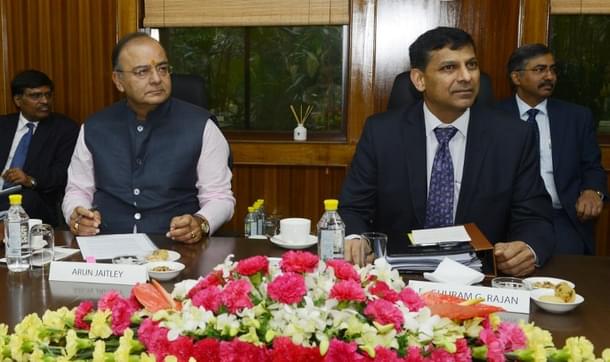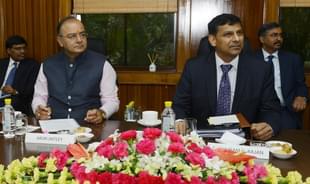Economy
Don’t Rush Into Full Rupee Convertibility
Sunil S Bhandare
Apr 21, 2015, 12:15 PM | Updated Feb 11, 2016, 09:11 AM IST
Save & read from anywhere!
Bookmark stories for easy access on any device or the Swarajya app.


Based on the experiences of various countries, India will have to put in place adequate safeguards. Full rupee convertibility is a great idea, but its time is yet to come.
What has prompted first the Reserve Bank of India (RBI) Governor and subsequently the Minister of State for Finance, Jayant Sinha, to suddenly flag off, at this stage of India’s economy, the issue of capital account convertibility is not very clear. Indeed, for the past several years, our policy makers have been struggling to contain inflation, put fiscal consolidation back on track, strengthen the banking and financial system and build up sufficient foreign exchange reserves to deal with any eventuality of volatile capital outflows. In the meantime, the minister is making the case for full capital account convertibility on grounds that it is needed “if India wants to be a global economy”.
However, neither a new policy format nor a timeframe is indicated for this. The RBI Governor is reported to have said that “we hope to get full capital account convertibility in a short number of years.”
India has progressively moved towards full current account convertibility, which comprises of external transactions on the current account – namely, payments and receipts for imports and exports of goods and services as well as similar transactions on invisible account like services. Over the last two decades, significant progress has also been made in the area of capital account convertibility. Thus, within certain sectoral limits, all capital inflows, including foreign direct investment (FDI) are fully convertible. Likewise, under the Liberalized Remittance Scheme, all resident individuals are now allowed to freely remit up to US$250,000 annually for any permissible current or capital account transaction or a combination of both.
This calibrated strategy towards rupee convertibility on both current and capital account has been widely commended internationally. In particular, this enabled our economy to combat the adverse fallout of the Asian Meltdown in August 1997 as well as of the Global Financial Crisis in 2008-09. It needs to be recalled that during both these events, occurring in a span of just over a decade, extreme volatility of capital flows aggravated the economic crisis in many countries.
Thus, the international community, including the International Monetary Fund (IMF), came to refocus its attention on the risks of open capital account, particularly with respect to short-term flows and its implications on the health and stability of the financial system in emerging markets like India.
Pre-Conditions for Capital Account Convertibility
What, then, are the essential building blocks for full capital account convertibility? And how soon can we aspire to achieve them? Various expert committees have, from time to time, recommended certain basic norms which need to be fulfilled for moving towards full convertibility. These include:
– Sustainable fiscal management (fiscal deficit to GDP ratio firmly reined in at 3 to 3.5% of GDP);
– Financial stability manifesting in healthy banking – with sound capital structure (i.e. healthy capital adequacy ratio), manageable non-performing assets (NPAs), 100 per cent marked-to-market valuation of banks’ investments, etc;
– Rigorous inflation targeting (a desirable inflation rate ~3%);
– Sound exchange rate management – a neutral real effective exchange rate or REER band (+/- 5%) to be monitored by the RBI; and
– Control over short-term external debt, reduction of the external debt service to total export earnings (goods & services) ratio from 25 per cent to 20 per cent , forex reserves to be not less than six months’ imports, etc.
Where are we with respect to such rigorous standards? India is delicately poised in most of these areas. Take the case of the latest Budget. Given the tight fiscal position, Finance Minister Arun Jaitley has been compelled to phase out his commitment towards fiscal consolidation over a longer time horizon, with the target of fiscal deficit of 3% of GDP being achieved now only in 2017-18.
Second, in terms of the recently signed Monetary Policy Framework Agreement, the RBI has to stay focused on gradual and durable disinflation in the economy, with a medium-term consumer price inflation (CPI) target of 4% (+/- 0.2%). Over the past three-odd years, with a stubbornly stiff monetary policy stance, the RBI could tame CPI inflation to its current level of 5.2%. But still, these are uncertain times. Going forward, this effort needs to be sustained around the crucial mid-point of 4%.
Third, our banking and financial sector is in the midst of significant transformational changes. The next two to three years are going to be crucial, with the emergence of a whole set of new banking institutions, be it payments banks, small finance banks, postal bank or a more vigorous foray into mobile/ digital banking. Even the existing banking institutions are going to see tremendous changes with their consolidation, restructuring and new business orientation. At a time when this mainstay of full rupee convertibility is being reformed, the policy makers would have to be extra cautious in pushing ahead the patently aggressive reforms agenda of full capital account convertibility.
Lastly, in the global context too, there is a series of risk factors. While reflecting on the World Economic Outlook, the latest IMF report points out that, apart from significant upside risk from oil prices and intensification of geopolitical tensions, “disruptive asset price shifts in financial markets remain a concern…triggers for turmoil include changing expectations about these elements as well as unexpected portfolio shifts”.
Equally significant are the RBI’s own concerns in its latest monetary policy. Thus, it highlights growing risks associated with [a] record high asset prices in many economies on account of “ultra low interest rates and reduction in risk premia”; [b] high portfolio flows to emerging market economies or EMEs (including India), and the possibility of sudden shifts in market sentiments; and [c] large and volatile movement of exchange rates, especially the sharp strengthening of the US dollar. This is quite apart from the RBI’s persistent apprehensions about the emerging inflation scenario in the country.
A Fascinating Policy Proposition, But…
What transpires, therefore, is the fact that full rupee convertibility may be a fascinating policy proposition, and its implementation would perhaps unleash many growth opportunities associated with globalization and a maturing modern economy for India. But there is no free lunch. Even the IMF, which, prior to the 1997 Asian Meltdown was so vigorously pushing countries to move towards full capital account convertibility, has been extremely cautious on this score in recent years.
Hence, based on the experiences of various countries over the last decade or more, India will have to put in place adequate safeguards – and all those have been reiterated by various expert committees from time to time. But somehow, we have missed out both on the sequencing of those major milestones and in accomplishing their substantive desirable outcomes. The message is clear: full rupee convertibility is a great idea, but its time is yet to come. And the ball is in the court of all those who propose it – they need to deliver the safeguards first, and then move on towards the ultimate goal.
Sunil S. Bhandare is a consulting economist and former economic advisor to the Tata Group.





